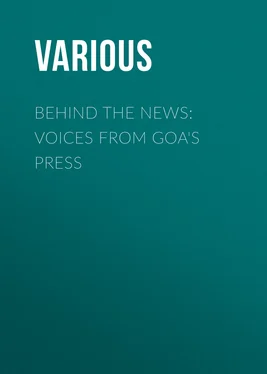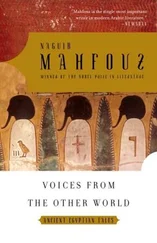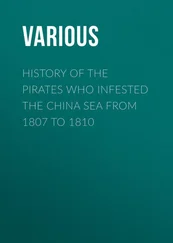Various - Behind the News - Voices from Goa's Press
Здесь есть возможность читать онлайн «Various - Behind the News - Voices from Goa's Press» — ознакомительный отрывок электронной книги совершенно бесплатно, а после прочтения отрывка купить полную версию. В некоторых случаях можно слушать аудио, скачать через торрент в формате fb2 и присутствует краткое содержание. Издательство: Иностранный паблик, Жанр: foreign_prose, foreign_antique, на английском языке. Описание произведения, (предисловие) а так же отзывы посетителей доступны на портале библиотеки ЛибКат.
- Название:Behind the News: Voices from Goa's Press
- Автор:
- Издательство:Иностранный паблик
- Жанр:
- Год:неизвестен
- ISBN:нет данных
- Рейтинг книги:4 / 5. Голосов: 1
-
Избранное:Добавить в избранное
- Отзывы:
-
Ваша оценка:
- 80
- 1
- 2
- 3
- 4
- 5
Behind the News: Voices from Goa's Press: краткое содержание, описание и аннотация
Предлагаем к чтению аннотацию, описание, краткое содержание или предисловие (зависит от того, что написал сам автор книги «Behind the News: Voices from Goa's Press»). Если вы не нашли необходимую информацию о книге — напишите в комментариях, мы постараемся отыскать её.
Behind the News: Voices from Goa's Press — читать онлайн ознакомительный отрывок
Ниже представлен текст книги, разбитый по страницам. Система сохранения места последней прочитанной страницы, позволяет с удобством читать онлайн бесплатно книгу «Behind the News: Voices from Goa's Press», без необходимости каждый раз заново искать на чём Вы остановились. Поставьте закладку, и сможете в любой момент перейти на страницу, на которой закончили чтение.
Интервал:
Закладка:
Back to the summer of 1978. As our 'unholy trinity' of Aleixo, Shekhar and me daily sat at the Govind Poy house on Abade Faria Road, Margao, preparing for our final B.Com. exams, I missed Kaka Singbal – a.k.a. Balsing, the Sunday columnist and Chief Reporter of NT – and Sripad P. Madkaikar, who at one time or the other published most of Goa's dailies. Both had called at home earlier in the day. Kaka left a note saying he had something "interesting" for me and would I kindly see him soon. I met him at his Patto quarters early next morning. He said he had quit NT and joined a newspaper that was going to be published – from Margao! He said the proprietor, Panduronga (Chalebab) Timblo – Papa to most of us – had made a blanket offer: whatever the NT offered me, he would offer more!
I immediately went to Navhind Bhavan. Dr. K.S.K. was seated with Fr. Lactancio Almeida, then Editor of Vauraddeancho Ixtt. I explained that it would help me cope with my Company Secretary studies from the comforts of my own home in Margao? The ex-Army man perennially dressed in cool white almost sprang from the chair, his neatly waxed whiskers bristling with rage: "Are you going to that W.C. s**t Times?"
He tried a different line, "Are you going to join my competitor and stab me in the chest?" And yet another, "Remember I am the P.A.C. (Press Advisory Committee) chairman for another three years – and as long as I'm around, I'll ensure you don't get an accreditation!!"
I was painfully aware that I was reneging on a promise, that by joining a competitor, I'd hurt the hand that had, in good measure, groomed me. But Company Secretaryship was my object – not journalism – and I honestly imagined that studying the course material and sending out its Response Sheets would be better done from home and without working on shifts, as I'd at NT. [I was, eventually, recompensed with poetic justice. I hadn't reckoned that joining a fledgling – nay, nascent – publication as its Staff Reporter, with added responsibility of news-gathering in South Goa (which meant re-writing copy from mofussil correspondents who largely hailed from a vernacular background) would be so engrossing an affair that I ended up sending not a single Response Sheet to the Institute of Company Secretaries of India!]
The West Coast Times (WCT) began churning out dummies by late-June 1978. My die was cast on June 6, 1978, by way of acceptance of the appointment letter, personally signed by Papa (Panduronga Timblo) himself. One of the most promising publishing ventures in the history of Goa's print media was about to take off?
The mid-'70s witnessed a boom in Goa's mining industry, both in terms of productivity and profitability. Panduronga Timblo Industrias (PTI) had evidently also made pots of cash, particularly from its manganese mines in Rivona, Quepem. While brother, Gurudas' Timblo Private Limited (TPL) had during this time invested in some far-sighted (but alas, badly managed) industrial enterprises, including fertilizers, rubber footwear and collapsible tubes, youngest brother, Modu's Sociedade de Fomento Industrial (SFI) was consolidating its strengths in mining and diversifying into hospitality. PTI did not lag behind – with Parshuram Paper Mills at Chiplun, industrial gases in Bangalore and, to the surprise of many, an English-language newspaper from Margao!
A rival to Hobson's choice NT
The last comment may be off the mark. As I later learnt from Papa himself, the project was conceived from a broader vision. Throughout the Konkan, from Ratnagiri district in Maharashtra to South Canara (now Dakshin Kannada) districts in Karnataka, no English-language daily was available before noon or afternoon those days. While the Mumbai dak editions of Times of India (ToI) and Indian Express (IE) did the honours in coastal Maharashtra, it was Bangalore's Deccan Herald in coastal Karnataka. Goa's NT, which took only a couple of hours less to reach Margao, could not be expected to travel beyond its borders on mass circulation basis – till WCT arrived, NT was in fact believed to have pegged its circulation (to avoid re-classification to a higher bracket, which implied higher minimum wages to staff and workers!)
It was Papa's dream to fill this void of a morning English-language daily for the entire Konkan, from Goa. Hence the West Coast in the newspaper's name. Competition to NT was only incidental. (I am not aware of any family feuds among Goa's mining magnates at the time and shall stand corrected if there was any such raison d' etat. If there really were any differences between the two families, they would be buried some years later: under blessings of the Partagal Swamiji, Papa's grand-daughter, Pallavi, was given in marriage to the Dempo headman, Vasantrao's son, Srinivas – current Chairman of the Dempo group.)
The infrastructure put into place to realize Papa's dream matched. A modern civil construction, meticulously designed, was put up at Davorlim, just beyond Margao's municipal boundary. Editorial, advertising and printing departments were housed under one roof for optimum synch. All sections of the newspaper's production process, from subbing to typesetting, from proof reading to optical processing, from plate-making to the final printing, were so located as to achieve maximum production speed. Attention was paid even to minor details, like sending galley proofs to the news desk in a jiffy. Such were the conveniences that the edition could go to bed by a leisurely 4.30am (the print run took barely half an hour.) Communication lines were made as reliable as possible, given frequent power interruptions. Both PTI and UNI ticker services were subscribed to (though only the PTI had a carrier station in Margao to cope with breakdowns.) A full-fledged bureau was set up in Panjim, connected to the editorial offices in Davorlim by teleprinter link.
The printing technology employed was said to be the best available in India – except in typesetting, where for some unknown reason, Lino machines were used instead of computers (maybe the value of lead scrap, in place of katchra bromides that computers generated those days, had something to do with it!) No more block-making for photographs and illustrations; these were optically processed directly to printing plates. A modern web offset printing machine was brought in (together with a Delhi-based Haryanvi operator who soon acquired fondness for palm feni from nearby Jose's bar and other unprintables from across the Rawanfond railway tracks!). The machine churned out, if I remember right, 50,000 copies/hour. Even the camera purchased for the Staff Photographer was a top-of-the-line German Leica, complete with an array of lenses and filters, worth a lakh of rupees of 1978. Krishna Kurwar managed the plant, under the GM-cum-Publisher, Madkaikar. The result was a refreshing, never-before-seen product on the landscape of Goa's print media.
To match, a high-profile editorial team was put together under the stewardship of Konkani-speaking M.G. Bailur and his Associate, Tulu-speaking Y.M. Hegde, both originally from South Canara. The backbone of the newspages, the News Editor, was P.R. Menon, the old and revered FPJ warhorse. The complement of three Chief Subs and about a dozen Subs was picked from various national dailies – Goa could come up with only two pairs of hands on the news desk. Being unfamiliar with local affairs, this cast added onus on Kaka Singbal and me to mark the priority of our dispatches in the initial days!
The news-gathering team headed by Kaka (assisted by Dharmanand Kamat in Panjim and Karamchand Furtado on the TP link) was, of course, entirely home-bred. I rushed college-mate Leslie St. Anne thro' a crash course in typing to join me in Margao. In South Goa, we had Radharao Gracias and Joey Rodrigues (both law students then), Felicio Esteves (who went on to become a Ministerial P.A. and co-author of the infamous Marks Scandal subsequently scooped by me for the FPJ), John Carlos Aguiar in Ponda, Vallabh Dessai in Quepem, Minguel Mascarenhas in Sanguem, Kelly Furtado in Vasco, and half a dozen stringers across South Goa. Manikrao (brother of the award-winning ToI photographer, Prabhakar M. Shirodkar) was our lensman, assisted by Lloyd Coutinho in Margao and Lui Godinho in Vasco, excellent photographers all, who provided the memorable photo inputs that shot the WCT to instant fame.
Читать дальшеИнтервал:
Закладка:
Похожие книги на «Behind the News: Voices from Goa's Press»
Представляем Вашему вниманию похожие книги на «Behind the News: Voices from Goa's Press» списком для выбора. Мы отобрали схожую по названию и смыслу литературу в надежде предоставить читателям больше вариантов отыскать новые, интересные, ещё непрочитанные произведения.
Обсуждение, отзывы о книге «Behind the News: Voices from Goa's Press» и просто собственные мнения читателей. Оставьте ваши комментарии, напишите, что Вы думаете о произведении, его смысле или главных героях. Укажите что конкретно понравилось, а что нет, и почему Вы так считаете.












